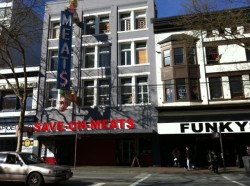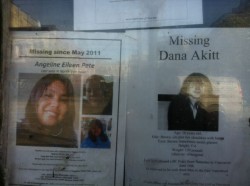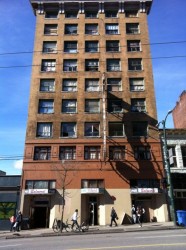 Visiting the Downtown Eastside (DTES) has churned up some contradictions for me, and resolving those contradictions requires re-thinking some questions I thought I already knew the answers to:
Visiting the Downtown Eastside (DTES) has churned up some contradictions for me, and resolving those contradictions requires re-thinking some questions I thought I already knew the answers to:
1) To what extent do people choose to live in the DTES, and to what extent are they stuck there?
2) Does the DTES community strengthen its residents or weaken them? Does it help mitigate the impact of addiction and poverty, or does it help perpetuate addiction and poverty?
I don’t know. Maybe they choose it and are stuck there. Maybe they are both strengthened and weakened by it. Maybe it mitigates and perpetuates. Maybe there’s no universal, static answer to these questions. (Maybe my questions are naïve.)
The Downtown Eastside neighbourhood is much more surreal and intense in real life than in books and videos. It isn’t just a backdrop against which addiction and poverty play themselves out. It’s an intrinsic part of the addiction and poverty.
Do you remember that woman in Florida who broke her leg and literally stayed on her couch for six years, until eventually her partner called 911 and the paramedics had to cut out a wall and take her and the couch to the hospital because the fabric of the couch had fused with her skin? That’s kind of how the Downtown Eastside struck me, only less domestic and more feral. A grotesque fusion of people and place.
(And what’s worse, separating the person from the couch, or leaving her there? For the record, the woman died after being surgically separated from the couch.)
To its credit, the Downtown Eastside is not an assortment of individuals suffering miserably in isolation from one another. It’s a very small, densely populated neighbourhood, and everybody seems to know each other. Collectively they’re a community, along with the people and services that support them. Many of them seem to share a sense of belonging there, and would probably be worse off elsewhere. (Which isn’t to say they necessarily belong there forever; but at this juncture in their lives, it’s possible that the worst place in the world may be the best place in the world for some of them.)
 The neighbourhood, by the way, is vigorously defending itself from gentrification. Vancouver’s a very expensive city, and this little piece of the downtown core would be worth a fortune if it were upscaled. But the fact that its residents are resisting gentrification makes me think that, on some level at least, they choose to be there. (Is it only because there’s nowhere left to go? Or is there more to it than that?)
The neighbourhood, by the way, is vigorously defending itself from gentrification. Vancouver’s a very expensive city, and this little piece of the downtown core would be worth a fortune if it were upscaled. But the fact that its residents are resisting gentrification makes me think that, on some level at least, they choose to be there. (Is it only because there’s nowhere left to go? Or is there more to it than that?)
When I was an addict in Ottawa, my community was critically important to me. We weren’t just a bunch of addicts, we were human beings with qualities and flaws and personalities. I’m sure my community around Bank & Gilmour held little appeal for outsiders looking in, but I felt connected and comfortable there. I was at home. I reminded myself of this as I walked through the Downtown Eastside…it’s the same principle, just more extreme.
 As a former addict, I can’t look at the residents of the DTES without thinking “There but for the grace of God…†And the only way to protect myself from the implications of that thought is by speculating that there must be something intrinsically wrong with them that isn’t wrong with me. Something that doomed them to – and protected me from – cataclysmic failure.
As a former addict, I can’t look at the residents of the DTES without thinking “There but for the grace of God…†And the only way to protect myself from the implications of that thought is by speculating that there must be something intrinsically wrong with them that isn’t wrong with me. Something that doomed them to – and protected me from – cataclysmic failure.
While that might be true in some cases, I don’t believe it’s true in general. There’s a complex web of factors influencing our paths through life. Genetics, family environment, mental illness, pre-natal conditions, structural disadvantage, abuse, racism, poverty, neglect and on and on. Some people’s addictions start out as survival strategies in the face of something even worse. Some people are more resilient for some reason. Some people just like taking drugs and living on the edge. The fact is, everybody’s got a unique story, and while there are recurring themes that can’t be ignored in the stories of addicts, you can’t generalize. And you can’t entirely discount luck either. Good luck or bad luck.
Most of us are doing the best we can with what we’ve got. And maybe that’s the case for people in the Downtown Eastside too. Maybe it’s even more the case for them.In a society where more money means more options, is it possible that the severely impoverished, addicted, disenfranchised and mentally ill have any choice left in anything? They’ve sunk to the bottom and they’ve not only stayed there, they’ve carved out a niche for themselves, squatting in the squalor and the misery. They’ve become part of it.
Maybe the only way they can cope with the reality of their circumstances is by perceiving themselves exclusively within the context of that reality. We all form our own ideas of what’s normal from the environments in which we live. If you’re addicted, mentally ill and poor, maybe the Downtown Eastside’s context of addiction, mental illness and poverty allows you to feel normal, whereas no other place possibly could. Maybe it’s the only place you can fit in and feel you’re not at the very bottom of the heap.
Ultimately, why does it matter if the DTES’s residents have any choice in where or how they live? Because I’m not sure it’s okay to force people to live under those conditions if they are powerless to leave. On the other hand, if this is where and how they choose to live, I don’t think it’s okay to kick them out of their own neighbourhood. Aren’t they entitled to take up a little bit of space? To have access to basic services? To belong somewhere?

















I work in a community mental health center and resilience is a topic that comes up daily. Some folks are able to bounce back from horrendous events and move on and others are knocked over by feathers and stay down. I have no clear reason for one reaction over the other, even after over 25 years of working with the severe and profoundly mentally ill.
I know one man who chose to live on the streets (and travelled the US as a homeless man) for over 25 years. He recently decided to “come in” and he is recovering from the ordeal/choice. He has some stories to tell about being homeless in America. I am trying to encourage him to write them down because he’s an educated (used to be a teacher) individual and is articulate. It would make for an interesting book.
Perhaps accepting that the addicted, mentally ill and poor are part of the social fabric of a City, any City is a major step to accepting their presence. We live in a Town and they are very much part of our reality although not as obvious to the average person or resident. There are a number of organizations trying to give them choices and/or make their lives better but it’s an uphill battle. I enjoyed your thoughtful and perceptive take on your visit to DTES.
Very thought-provoking. (Also, I had never heard of the woman in Florida with the broken leg. So disturbing!)
Two things strike me, the mild climate makes it the last safe place to be homeless in Canada…..and the issue of resilience. My partner had me watch a ted talk by a schizophrenic who battled against the health care system to reclaim her place in the world – she became a psychologist herself. What struck me is how carefully I’ve guarded my other voice – she talks about me in third person and essentially feeds me future fairy tales about my life whenever I’m stressed out and it started when I needed to disassociate from abuse. Mental illness is as much protective as it is rehabilitating. Had I ever shared her with a doctor I have no doubt I’d be in much worse shape than I am, and I dropped out of an art therapist because she so easily exposes herself in automatic writing exercises. I turned to her instead of drugs and alcohol. She helped me through periods of homelessness and the very real threat of being homeless again.
dehabilitating
Seamy Underbelly, Part II « knitnut.net
—
Hi, Neat post. There is a problem together with your site in internet explorer,
might check this? IE still is the market leader and a big component to other people will omit your magnificent writing
due to this problem.
The fact that phen375 is manufactured under governed conditions,
and lay out in extreme detail in their web-site just
what phen375 will do to your body. Boost your metabolism at the moment is
that you can trust on your weight loss. It primarily
is made up of several ingredients which all work in synergy
with each other to maximize safe and effective weight loss.
Keep in mind that the need of your body is affected.